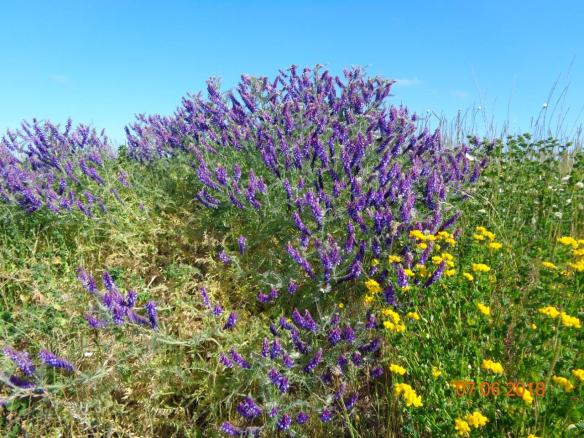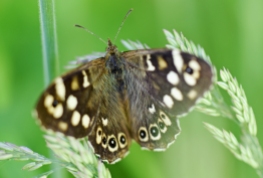Road verges have been in the news of late. There is a growing realisation that these areas, if managed sympathetically for nature, can be places where wildflowers and wildlife can flourish, and high on the list of potential beneficiaries are pollinators.

Much of what you may have read or seen will doubtless have been centred on England. There has been widespread coverage of actions in the likes of Rotherham, Newcastle and Sheffield across the media. And much of this is down to the energy of Plantlife who had been campaigning determinedly to make the most of our verges.
Now there are good news stories emerging in Scotland too.

Take the Aberdeen Western Peripheral Route/Balmedie to Tipperty project for example. This 36 mile route provides a much-needed bypass around Aberdeen, and was one of the biggest construction projects seen in Scotland. Given the scale of the project, there were inevitably some challenges, but in equal measure it offered opportunities.

The funding partnership of Transport Scotland, Aberdeen City Council and Aberdeenshire Council set a fine example from the off. They have overseen the project around Aberdeen which was procured as a Design Build Finance and Operation (DBFO) scheme using a joint venture partnership of contractors. The consultants managing the scheme on Transport Scotland’s behalf were Jacobs.
The work in the north east followed what is now Transport Scotland’s favoured model. This requires the use of native plant species, of local provenance, in all works on Scotland’s trunk road network. It’s an approach which has been championed for the past two decades, and the majority of new works now include significant areas of wildflower seeding as an integral part of project plans.

You can see the benefits of this approach clearly around Aberdeen.
At Derbeth Overbridge, which carries a new access road over the bypass, there are large numbers of ox-eye daisies and white clover on the embankments and cuttings. For hard pressed pollinators clovers and oxeye daisies are a most welcome addition to their resources, and both were firmly part of the planning here.
The Balmedie to Tipperty dualling section of the A90 attracted lots of favourable comments as the verges were looking spectacularly colourful earlier this summer with great swathes of poppies and sea mayweed. The area around the Balmedie junction was a particular highlight.

In isolation these sites are good, viewed as part of a larger picture they are great. As one of my good friends in Aberdeen said recently “The great thing about roads is that they are all connected, so they have huge potential to be a valuable part of a pollinator habitat network.”
Not far from Derbeth Overbridge is a sizable patch of kidney vetch. A coloniser of poor, bare soil it is a great source of nectar and pollen for bees and hoverflies. It is one thing for good food sources to emerge, it is quite another for them to avoid the mowing machines. But here too the news is good. Mowing seems to be confined to a narrow strip adjacent to the kerbside and around signs and such like. As a result things like white clover are abundant along the bypass verges and this relaxed and complementary mowing regime is certainly paying dividends for pollinating insects.
Few projects are perfect and there is – as Glen Campbell sang in Rhinestone Cowboy – compromising to be done. But even so there is a lot of a positive nature that the Aberdeen bypass can reflect on.
In the course of any construction project there is a balance to be struck which we measure in terms of net biodiversity gain or loss. But this project certainly tried to ensure the balance was on the positive side.

The installation of wildlife bridges at Kingcausie and Kirkhill was a first for a Scottish trunk road and is a sign that the need to provide safe crossings for wildlife (and thereby join habitats) is rising up the agenda quickly. You may have seen this on the continent, now it is making inroads on our own shores.
Transport Scotland has had this kind of positive outcome in their sights for some time now. Over a period of time, successive schemes combined with a verge management policy that actively encourages the development of species rich grass swards have taken centre stage.
Through the introduction of mowing regimes that minimise cutting in areas where there are no operational or safety issues, you can begin to see a noticeable increase in the flora content of our road verges.
Arguably this has been particularly evident this year – perhaps partly related to optimum weather conditions – with many roads around the Scottish network displaying abundant displays of wildflowers, native grasses and other desirable ground cover species.
You can always build on success. Hence the high profile and ongoing A9 Dualling Programme has seen Transport Scotland aim to establish a Supply Contract for all the native seeding requirements across the whole series of schemes using local origin collections.

But let’s dwell on success and return to Aberdeen. Relaxed mowing regimes, abundant food sources, connectivity … little wonder the Aberdeen bypass is catching positive headlines, and pollinators are amongst the creatures clearly benefitting.
READ MORE …
You can find out more about Transport Scotland’s approach to verge management in their excellent landscape policy document, Fitting Landscapes. Transport Scotland recently supported PlantLife in the preparation of their soon to be published best-practice guidance on good management of road verges .
Images 1 and 3 courtesy and copyright Michalina Wojcik of Jacobs, Images 4 and 5 courtesy of Angus Corby of Transport Scotland.














